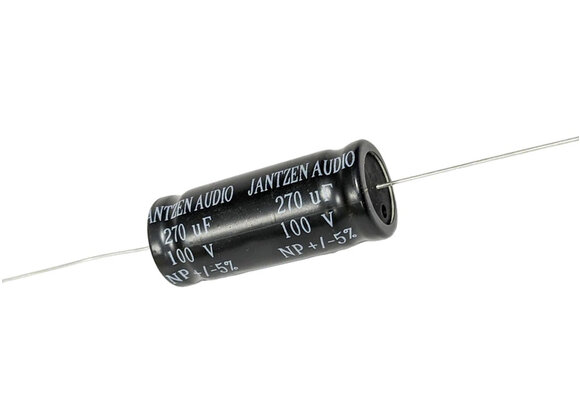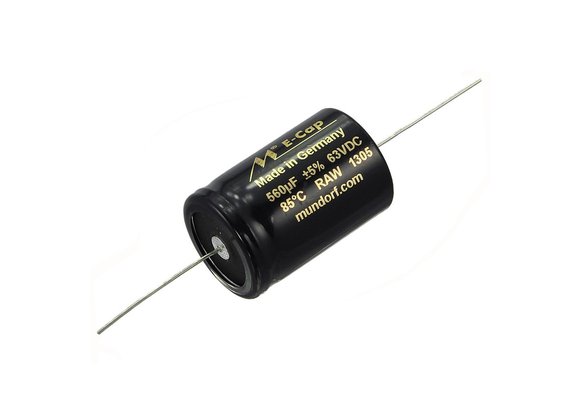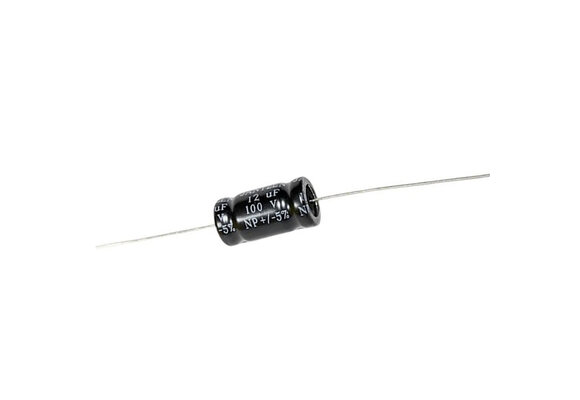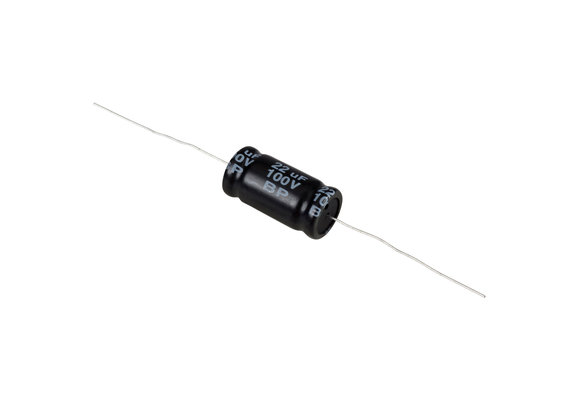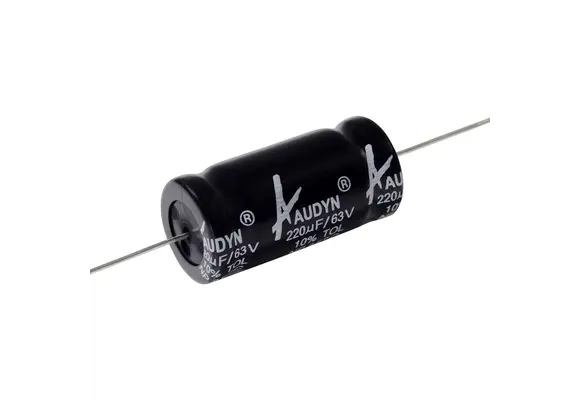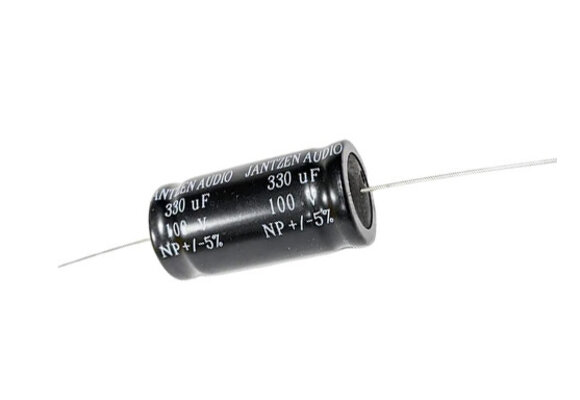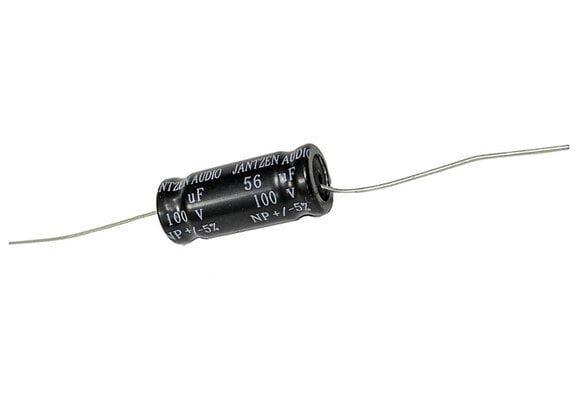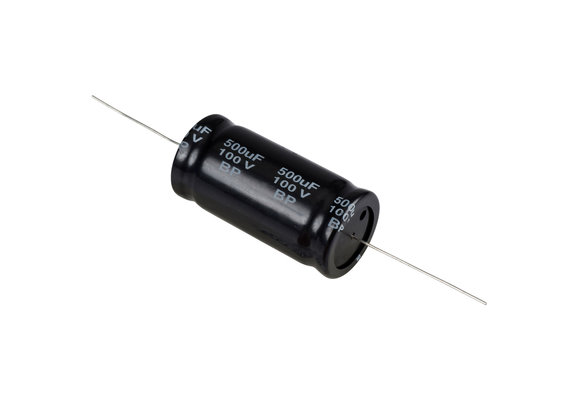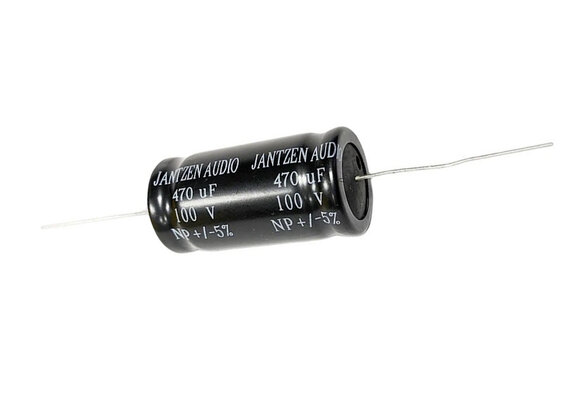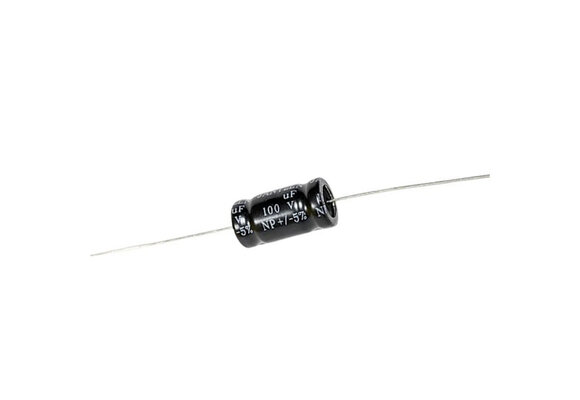Wat is een elektrolytische condensator?
Niet-gepolariseerde elektrolytische condensatoren hebben een folie waarvan het oppervlak door een uniek etsproces ruw is gemaakt, waardoor het oppervlak groter wordt. Hierdoor kunnen ze een veel hogere capaciteit hebben dan andere, meer eenvoudige types. De door SoundImports aangeboden elektrolytische condensatoren zijn alle niet-gepolariseerd en zijn verkrijgbaar met waarden van 1 tot 4700 uF. De niet-gepolariseerde elektrolytische condensatoren die SoundImports aanbiedt kunnen hoge werkspanningen aan tot 100V. Ze zijn handig op plaatsen waar een hoge rimpelstroom nodig is, zoals bij voedingen. Aangezien de capaciteit van condensatoren evenredig is met hun oppervlakte, levert dit proces de kleinste en goedkoopste soort condensatoren op. Dit proces verzwakt echter ook de geluidskwaliteit in vergelijking met niet-geëtste versies. Over het algemeen is een elektrolytische condensator een goed type condensator. Ze zijn perfect voor gebruik in een crossover en ideaal voor een low-budget project! Echter, als u op zoek bent naar een hogere kwaliteit, voel je vrij om te kijken op onze film / folie condensatoren!
Hier bij SoundImports, kunt u kopen niet-gepolariseerde elektrolytische condensatoren van Jantzen Audio en Mundorf!
Wat zijn de voor- en nadelen van een elektrolytische condensator?
Tantaal condensatoren zijn de meest voorkomende soort van elektrolytische condensator. Andere worden ingedeeld volgens de diëlektrische pasta of het soort gas dat wordt gebruikt. Elektrolytisch aluminium en polypyreen komen vaak voor. In elk geval kan de capaciteit van een elektrolytische condensator alleen worden geëvenaard door een veel grotere niet-elektrolytische condensator (zoals papier- of mica-condensatoren). Daarom wordt hun grootte als een van de belangrijkste voordelen beschouwd.
Elektrolytische condensatoren vereisen meer zorg dan andere condensatoren vanwege hun constructie en polariteitsgevoelige werking. Verkeerd gebouwde elektrolytische condensatoren (omgekeerd gepolariseerd) zullen niet de juiste capaciteit bereiken en kunnen interne gasdruk creëren, met een (kleine) explosie tot gevolg. Elektrolytische condensatoren zijn vaak gevoeliger voor temperatuur dan andere soorten condensatoren. Daarom wordt hun gevoeligheid als een van hun nadelen beschouwd.
Hoe werkt een elektrolytische condensator?
Elektrolytische condensatoren, zoals de meeste typische condensatoren, slaan elektrische energie statisch op door isolatie in een elektrisch veld op te laden tussen twee elektroden in de diëlektrische oxidelaag. De kathode, die als tweede elektrode van de condensator dient, bestaat uit een niet-vast of vast elektrolyt.
Wat is het verschil tussen een elektrolytische condensator en een film/folie condensator?
Het belangrijkste verschil tussen een elektrolytische condensator en een film/folie condensator is terug te vinden in het type en de constructie van het gebruikte diëlektricum. Terwijl de actieve component van elektrolytische condensatoren bestaat uit aluminium (anode- en kathodefolie), papier en elektrolyt, wordt de film/folie-condensator opgebouwd uit een met metaal beklede plastic film die de elektroden vormt. Actieve elektrolytische aluminiumcondensatoren hebben een energiedichtheid die tot tienmaal groter is dan die van polypropyleenfilmcondensatoren. De niet-gepolariseerde elektrolytische condensatoren hier bij SoundImports zijn de beste goedkope oplossingen voor passieve luidspreker cross-overs!

 Home audio
Home audio  Audio componenten
Audio componenten  Crossover componenten
Crossover componenten  Test- & meetapparatuur
Test- & meetapparatuur  DIY kits
DIY kits  Accessoires
Accessoires  Nieuwe producten
Nieuwe producten  Home audio
Home audio  Audio componenten
Audio componenten  Crossover componenten
Crossover componenten  Test- & meetapparatuur
Test- & meetapparatuur  DIY kits
DIY kits  Accessoires
Accessoires  Nieuwe producten
Nieuwe producten  Speakers
Speakers Versterkers
Versterkers DAC converters
DAC converters DSP modules
DSP modules Draaitafels
Draaitafels Streamers
Streamers Woofers
Woofers Tweeters
Tweeters Exciters
Exciters Bass shakers
Bass shakers Plaatversterkers
Plaatversterkers Versterker modules
Versterker modules Single board computers
Single board computers Geassembleerde crossovers
Geassembleerde crossovers Printed Circuit Boards (PCB)
Printed Circuit Boards (PCB) Condensatoren
Condensatoren Weerstanden
Weerstanden Spoelen
Spoelen Circuit Breakers
Circuit Breakers Crossover tools
Crossover tools Kroonsteen
Kroonsteen Akoestische metingen
Akoestische metingen Elektrische metingen
Elektrische metingen Geluidsniveaumeters
Geluidsniveaumeters DIY versterker kits
DIY versterker kits DIY component packs
DIY component packs DIY speaker kit
DIY speaker kit DIY subwoofer kits
DIY subwoofer kits DIY bluetooth speakers
DIY bluetooth speakers DIY elektronische kits
DIY elektronische kits Binding posts
Binding posts Kabinet Hardware
Kabinet Hardware Kabels
Kabels Connectors
Connectors Luidsprekerkasten
Luidsprekerkasten Elektromechaniek
Elektromechaniek Voedingen
Voedingen Luidspreker reparatie
Luidspreker reparatie Werkplaats & Gereedschap
Werkplaats & Gereedschap Versterkeraccessoires
Versterkeraccessoires Standaarden & beugels
Standaarden & beugels Cadeaubon
Cadeaubon Boeken
Boeken Nieuwe producten
Nieuwe producten









 Speakers
Speakers Versterkers
Versterkers DAC converters
DAC converters DSP modules
DSP modules Draaitafels
Draaitafels Streamers
Streamers Woofers
Woofers Tweeters
Tweeters Exciters
Exciters Bass shakers
Bass shakers Plaatversterkers
Plaatversterkers Versterker modules
Versterker modules Single board computers
Single board computers Geassembleerde crossovers
Geassembleerde crossovers Printed Circuit Boards (PCB)
Printed Circuit Boards (PCB) Condensatoren
Condensatoren Weerstanden
Weerstanden Spoelen
Spoelen Circuit Breakers
Circuit Breakers Crossover tools
Crossover tools Kroonsteen
Kroonsteen Akoestische metingen
Akoestische metingen Elektrische metingen
Elektrische metingen Geluidsniveaumeters
Geluidsniveaumeters DIY versterker kits
DIY versterker kits DIY component packs
DIY component packs DIY speaker kit
DIY speaker kit DIY subwoofer kits
DIY subwoofer kits DIY bluetooth speakers
DIY bluetooth speakers DIY elektronische kits
DIY elektronische kits Binding posts
Binding posts Kabinet Hardware
Kabinet Hardware Kabels
Kabels Connectors
Connectors Luidsprekerkasten
Luidsprekerkasten Elektromechaniek
Elektromechaniek Voedingen
Voedingen Luidspreker reparatie
Luidspreker reparatie Werkplaats & Gereedschap
Werkplaats & Gereedschap Versterkeraccessoires
Versterkeraccessoires Standaarden & beugels
Standaarden & beugels Cadeaubon
Cadeaubon Boeken
Boeken Nieuwe producten
Nieuwe producten


